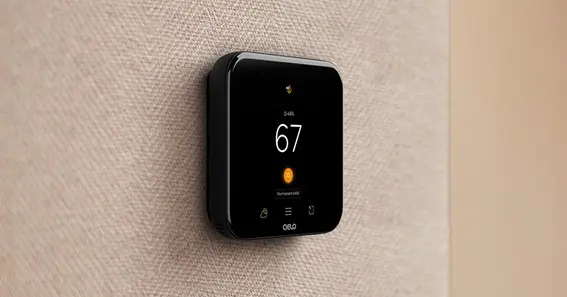What is auxiliary heat? Most cold-weather and heat pump users are familiar with the phrase. Despite its importance for winter heating, only some people comprehend auxiliary heat. This article helps you in knowing what is auxiliary heat, how it works, and when it goes on may helping you regulate your home’s heating system and save money.
What Is Auxiliary Heat?
When your main heat pump fails, auxiliary heat keeps your home warm. Heat pumps are ideal for moderate climates because they transfer heat well. However, they may perform less successfully when temperatures drop significantly because there is less heat to circulate. This provides extra heat to keep your house warm.
Electric resistance heating is usually auxiliary heat. However, gas heaters, wood fires, and other backup heating can be used. The auxiliary heating system is activated when the primary system can’t meet demand. Switching from the main system to the backup system is usually seamless, and few notice. This was a briefing on what is auxiliary heat.
Also Read N: Tyler Stanaland Birthday: When Does He Celebrate?
How Does Auxiliary Heat Work?

After knowing what is auxiliary heat, next you to understand it’s function. First, learn how a heat pump works to comprehend additional heat. Despite the weather, a heat pump may transport warm air from outside into your home. Heat pumps perform less effectively below 35 degrees Fahrenheit (1.5 degrees Celsius). Your home will immediately switch to backup heat if the heat pump fails.
The thermometer measures indoor temperature and regulates secondary heat. The backup heating system activates when the timer detects a dip in temperature, even while the heat pump is running. This additional heat works with the heat pump to maintain temperature.
Remember that more heat requires more energy than the heat pump. For instance, electric resistance heating uses more power to produce the same heat. On really cold days, more heat is essential, but using it too often might raise energy expenditures.
Also Read P: Tyler Stanaland Mom: What We Know About His Family And Background
When Does Auxiliary Heat Kick In?
Weather and heat pump performance determine when the extra heat is switched on. In areas with frequent cold weather, more heat may be required. The speed at which the temperature inside is lowering causes more heat, not merely the outside temperature.
If your heat pump fails and your thermostat is set to 70°F (21°C), your home will cool fast. To prevent further temperature decline, the thermostat will switch on more heat. Cold snaps or rapid temperature reductions might cause this even if its temperature is above freezing.
Is Auxiliary Heat The Same As Emergency Heat?

Despite their common use, auxiliary and emergency heat are different. Both are backup home heating methods, although they serve distinct purposes.
The timer switches on backup heat when the heat pump fails to maintain a comfortable house. It’s a natural change that happens without user intervention. If the heat pump fails, you can manually activate emergency heat on the thermostat.
Emergency backup heating systems, such as electric resistance heating or heaters, should replace the heat pump. Emergency heat should only be used when the heat pump isn’t working because it raises energy expenditures.
In conclusion, auxiliary heat is an automated component that aids the heat pump, whereas emergency heat is a human option utilized when the primary system fails.
Impact Of Auxiliary Heat On Energy Bills
On learning what is auxiliary heat, you need to know its impact on the energy bill. Homeowners worry that installing heat may hike energy expenditures. As said, heat pumps are more efficient than electric resistance heating and other supplementary heat sources. This waste increases energy utilization and power prices.
How often you use the additional heat affects your energy expenditures. If you live in a warm climate where the heat pump can heat most of the time, you may just need supplemental heat sometimes, which would cost nothing. In colder climates or during harsh winters, more heat may be utilized more often, raising energy expenses.
Signs That Your Auxiliary Heat Is Running Too Often
If you’re auxiliary heat is on more often than usual, your heat pump or timer may be broken. There are several methods to identify whether your backup heat is running too much, which might raise your energy expenses.
A fast winter energy bill increase is a common indicator. If your energy usage rises significantly from past years, you may need to use more heat. If your thermostat’s secondary heat indication is on more often, investigate.
Another clue is if your heat pump is always on, yet your home doesn’t need to be warmer. This may indicate that the heat pump is struggling to meet demand, causing the extra heat to turn on more often.
Conclusion
Finally, auxiliary heat is essential for your home’s heating system, especially in cold weather when your heat pump may not work. Knowing how auxiliary heat works, when it goes on, and how it differs from emergency heat helps you regulate your home’s heat. Maintenance of your heat pump and insulation may make your house warmer and more pleasant while cutting energy expenses. This was a brief article on what is auxiliary heat.
FAQ
Helper Heat—What?
On chilly days, your auxiliary heat system kicks in when your main heat pump can’t keep the house warm.
When Does The Additional Heat Work?
The additional heat is generated by itself when the heat pump has problems maintaining the target temperature, generally due to the cold outdoors or a thaw cycle.
Are Emergency And Excess Heat The Same?
Auxiliary heat operates on its own, whereas emergency heat is a manual option for when the heat pump fails.
Does Greater Heat Raise Energy Prices?
Yes, auxiliary heat, especially electric resistance heating, is not as good as the heat pump and can raise your energy expenditures if used frequently.
How Can I Reduce Heat Use?
Better insulation, a regulated thermostat, and heat pump maintenance can reduce your need for auxiliary heat.
Sources:










